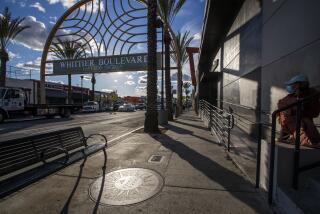First Lutheran Decides to Go Its Own Way : Camarillo Church Calls New Denomination Too Liberal
- Share via
The bulletin handed out to worshipers at First Lutheran Church of Camarillo the first Sunday in January proudly trumpeted the birth of a new denomination, the Evangelical Lutheran Church in America, now the nation’s fourth-largest Protestant body.
However, the 200 or so members of First Lutheran gathered inside the simple adobe brick and wood sanctuary that day were not about to celebrate the ELCA’s formal start-up.
For them, the day marked the start of a less well-charted course. Rather than join the ELCA, as the overwhelming majority of the nation’s nearly 5,000 other former American Lutheran Church congregations had done, the Camarillo congregation had opted out of the mainstream in favor of an obscure and decidedly more conservative branch of Lutheranism.
Depending on one’s viewpoint, First Lutheran members are either courageous believers willing to face criticism for holding to their Christian faith, or reactionary rebels seeking to prevent change from affecting their church.
Either way, the congregation--31 years old, with 751 overwhelmingly Anglo members--appears united behind its controversial pastor, the Rev. Orville Hiepler, and willing to go its separate way.
One critic of the congregation’s action is the Rev. Nelson Trout, who as South Pacific District bishop for the ALC, sought to steer First Lutheran into the ELCA fold.
“The congregation just reflects the conservative views of its pastor,” said Trout, who was the ALC’s only black bishop and who now works for the ELCA. “He pushed his people so hard, they felt they just had to leave. They never gave merger a chance.”
Hiepler defends the move as justified by the relatively liberal direction taken by the ELCA.
“We are the ones in line with historical Lutheranism, not those ‘New Age’ Lutherans who have gotten away from it in the new church,” he said.
“I guess we’ll have to do something about those bulletins, though,” the 67-year-old, North Dakota-born pastor added with a grin. “We haven’t had time, but we do need to get some that reflect where we stand.”
Sweeping Lutheran Changes
The past year has brought sweeping changes to Lutheranism in this country. After a decade of talk and planning, the Lutheran Church in America, at the time, this nation’s largest Lutheran denomination, the small Assn. of Evangelical Lutheran Churches and the ALC completed the process of merging into the new 5.3-million member ELCA.
The process was not without its detractors, however. Chief among them were conservatives within the ALC who objected to the new denomination’s constitution, which was crafted by the more liberal leaders of the three merging church bodies.
Their aim was to move American Lutheranism beyond its Midwestern, predominantly Scandinavian and Germanic ethnic roots so that it might flourish in the urban melting pot of contemporary America.
But conservatives, including Hiepler and the majority of his congregation, deplored the constitution’s insistence that a quota system be employed to ensure that minorities, women and lay people are adequately represented on committees and at conventions of the new denomination.
“If I was told we had to send one Negro, one woman or one Hispanic, I’d be upset,” said Jack Forbes, a member of First Lutheran’s council of elders.
“Don’t get me wrong, I’m not against that, but I’d want to know if they are qualified, and if they weren’t and we just had one or two to choose from, I just wouldn’t want them representing me.”
Quota System Defended
In response, Bishop J. Roger Anderson of the ELCA’s Southern California West Synod based in Los Angeles, said the quota system was included in the constitution “as a way to follow through on the church’s commitment to move toward fairer representation.
“We needed the challenge and I think those who object should consider just what is their commitment to an inclusive church.”
Conservatives also bristled at what they perceived as the constitution’s emphasis on social activism over evangelism and biblical literalism, and they fumed over the new denomination’s association with the National Council of Churches and the World Council of Churches, both of which they consider to be soft on communism and supportive of Third World revolutionary groups.
“The ELCA is just too liberal all around,” said Mike Owens of Moorpark, a First Lutheran member who works for Hughes Aircraft at Point Mugu Naval Air Station.
Because the ALC’s constitution required individual congregations to vote on the merger process, conservatives had a forum in which to voice their dissatisfaction.
When the results were in, almost a fifth of the ALC’s nearly 5,000 congregations had voted against merger, including First Lutheran of Camarillo. At First Lutheran, 87% of the members opposed merger, and a few of those who supported the move left the congregation, according to interviews with current members.
The large number of congregations voting against merger surprised denomination leaders, who for months had played down the opposition. But with only a two-thirds vote needed to ratify the action, merger was officially sanctioned.
Faced With a Decision
Congregations that had opposed merger were then faced with the choice of going along with the move for the sake of unity and tradition, or taking another vote to bolt the new denomination.
So far, only about 45 former ALC congregations around the nation have chosen to leave the merged church, according to an ELCA spokeswoman in Chicago, although splinter groups from congregations that elected to stay have also dropped out.
Of the approximately 111 former ALC congregations in the greater Los Angeles area, about 13 voted against merger. But so far, only four--Trinity Lutheran of San Pedro, Cross and Crown Lutheran Church in Montebello and University Lutheran in Long Beach, in addition to First Lutheran--have officially pulled out of the merged church.
One those that elected to stay in the ELCA is Bethel Lutheran Church in Encino. “It doesn’t help to take your ball and go home,” said the Rev. John Stewart of Bethel Lutheran. “We want to be a part of the answer,” he said at the time.
Hiepler was a prominent participant in the anti-merger campaign, both locally and nationally. He spoke against merger at a meeting in San Gabriel attended by representatives of 19 Los Angeles-area congregations and traveled often to the Midwest to take part in meetings that led to the formation of the American Assn. of Lutheran Churches (AALC), a conservative break-away denomination that counts about 20 former ALC churches among its members.
Yet First Lutheran members say Hiepler did not try to influence his congregation to oppose merger, as Trout contended. Rather, they say, Hiepler supported an open process that allowed members to explore a range of options, including the possibility of staying in the merged church.
Speakers from seven different Lutheran groups were invited to address the congregation and the members were polled several times on what course they should take, Hiepler’s defenders said.
“We had meeting upon meeting and Pastor Hiepler always told us to make up our own minds,” said Beverly Lusk of Camarillo, a 7-year member of the congregation. “In most ALC churches, the pastor just told the people how to vote on merger.
“We took it upon ourselves to investigate, I’d say we most definitely knew more about the issues than most people.”
In the end, 90% of First Lutheran’s members voted to affiliate with the Minneapolis-based Assn. of Free Lutheran Churches, a minuscule denomination of just 25,000 members, most of them in the Midwest, despite Hiepler’s involvement with the fledgling AALC.
“The congregation decided ‘Why reinvent the wheel?,’ ” said Hiepler, who supports the move. “The AFLC already exists and has a seminary, and the congregation felt that was preferable to getting involved with a new group trying to get established.”
The Rev. Richard Snipstead, the AFLC’s president, said First Lutheran is the first California congregation to affiliate with the independently minded denomination.
“Our heritage is congregational autonomy, an inerrant view of Scripture and we’re strong on evangelism, both locally and abroad. I suppose there are those who call us fundamentalist, and I don’t object to that,” he said.
In short, added Hiepler, the Assn. of Free Lutheran Churches is very much like the American Lutheran Church was “back in 1960, before they tampered with the inerrancy and infallibility of the Bible and before they started ordaining women.
“We’re just remaining as we were in 1960. Why shouldn’t we have that option?”
More to Read
Sign up for Essential California
The most important California stories and recommendations in your inbox every morning.
You may occasionally receive promotional content from the Los Angeles Times.













